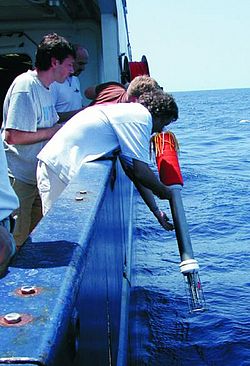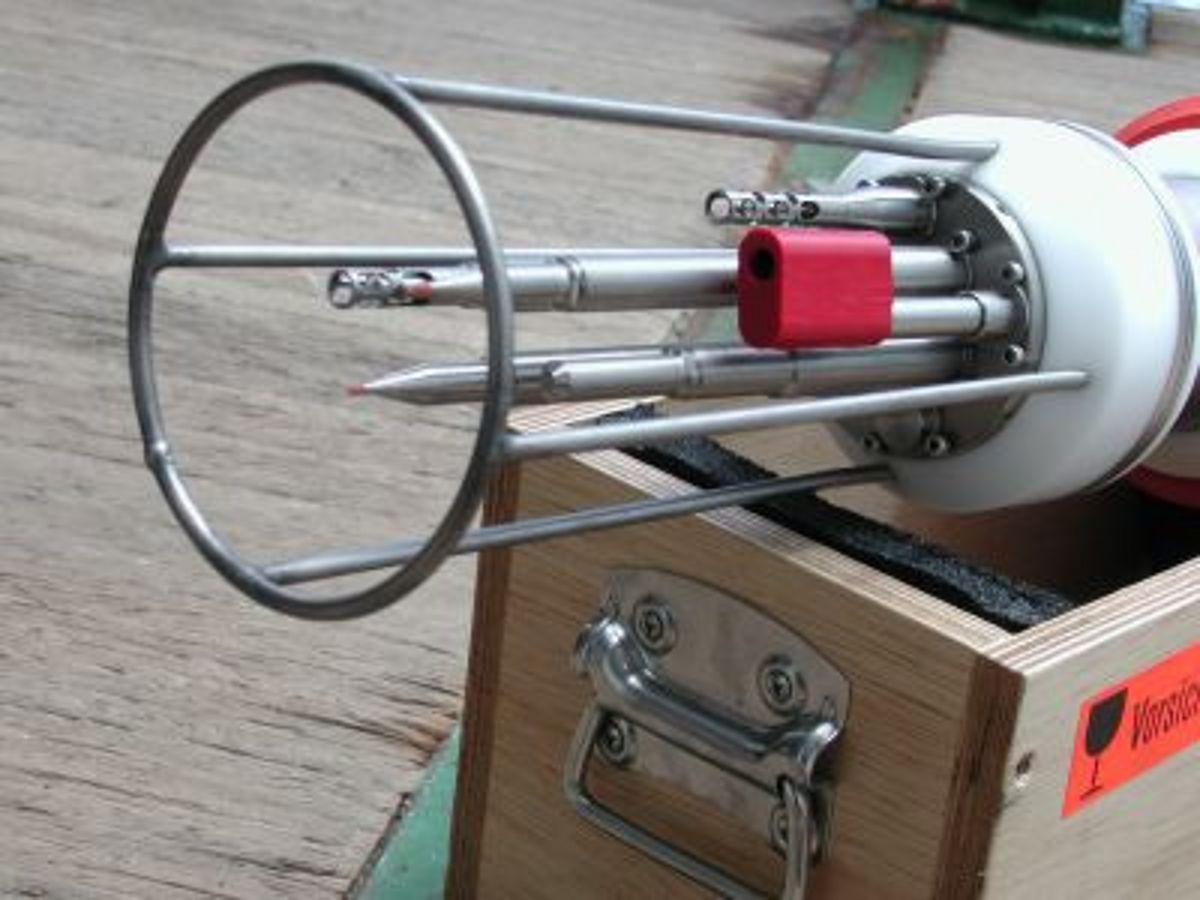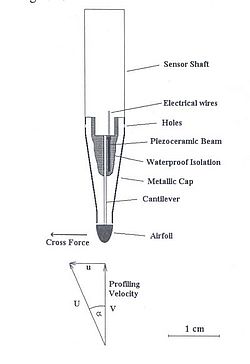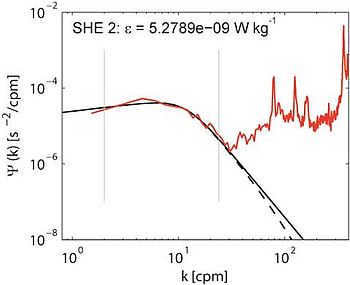Microstructure Profiler
General description of the system
The microstructure profiler is an instrument designed to measure velocity shear and temperature variability on vertical scales of less than a millimeter and simultaneously record other physical parameters of the ocean. The profiler is constructed to descent to depths as far as 2000m. In order to obtain data on micro scales, the probe operates with a very high sampling rate of 1024 Hz and is equipped with two shear probes (airfoil), a fast temperature sensor (microthermistor), an acceleration sensor, tilt sensors as well as the standard CTD sensors which measure temperature, conductivity and pressure with a lower sampling rate of 24 Hz. The profiler is a free falling device, which is adjusted to descend at a rate of 0.6 m/s in order to optimize the data processing of the airfoil probes. As the descent of the profiler itself disturbs the water column causing additional turbulence, it is important that the fast temperature sensor as well as the airfoil probes are mounted at the front of the profiler to ensure sampling of the turbulence, which is present in the unperturbed water column. The free falling instrument transmits the data via a Kevlar cable to the deck unit, which is installed onboard the ship and directly stores the measurements. To insure that the profiler can fall freely without causing tension on the cable, which would induce additional vibrations and perturb the measurements, the cable is veered at a rather high speed with a special winch.
Measurements of turbulent dissipation rates
The dissipation rate of turbulent kinetic energy is a fundamental parameter to quantify the strength of turbulence and the resulting mixing processes in the ocean. Diapycnal mixing in the ocean is caused by the molecular diffusion of heat and salt. However, molecular diffusion is very slow. Turbulent motions increase local gradients of these quantities and are thus essential for setting the magnitude of diapycnal mixing within the ocean. As these turbulent motions operate on vertical scales of a few meters down to millimeters, they are termed the micro scales of the ocean.
Our understanding of mixing processes and diapycnal transports is still incomplete. Microstructure observations have been conducted since 1978. However, the data coverage within the global ocean is still rather sparse.
Increased observations of turbulent processes aim at
- A better understanding of the spatial and temporal variability of diapycnal mixing.
- Improving existing mixing parameterization schemes
- Estimating diapycnal fluxes of heat, salt and biogeochemical tracers
Front view of the MSS probe with two airfoil shear probes (red tips), acceleration sensor (cylindric sensor) und microstructure temperature sensor (behind the shear sensor), as well as CTD-unit (closer to the case). The measurement devices are protected with a metal frame.
- Shear sensors
Airfoil microstructure sensors are usually used to measure small scale velocity fluctuations in the ocean. The sensors operate with a frequency of 1024 Hz and have a response time of 4 ms. The sensors are oriented such as that the average velocity, which is given by the movement of the probe, agrees with the axis of the rotational axis of the axialsymmetric airfoil probe. As the sensors are not sensitive for axial forces, only the transversal forces of the turbulent motion can cause a buoyancy force for the airfoil. A piezo-ceramic device, which is attached to the airfoil feels the buoyancy force and induces a voltage, which is proportional to the instantaneous transversal component of the velocity field. The airfoil has a length of 3.5mm and a diameter of 3 mm. The spatial resolution of the shear sensor is about 5mm.
- Accelaration sensor: measures the lateral acceleration of the microstructure probe due to vibrations of the profiler. This data is valuable information for data processing to remove the influence of the profiler from the recorded shear data. The acceleration sensor is mounted to the tip of the profiler close to the shear sensors.
-
Fast temperature sensor: For measure the microstructure of the temperature, a sensor based on the micro thermistor (NTC) FP07 (thermometrices, USA) is mounted on the profiler. This sensor also measures at the sampling rate of 1024 Hz and its response time is dependent on the sinking speed of the profiler (around 7-12 ms).
Background and data analysis
Dissipation rate measurements with shear sensors (of the type airfoil) were first introduced 1974 by Crawford und Osborn (1978) during the GARP (global atmospheric research program) program. They suggested inferring turbulent dissipation rates either via the variance of the micro-scale shear or via the adaptation of the measured spectrum to the universal spectrum. With some modifications both methods are still applicable.






